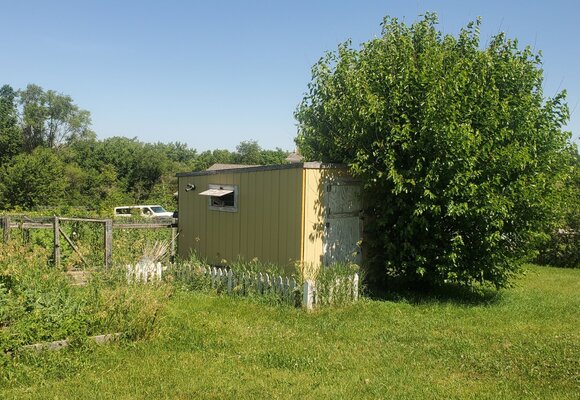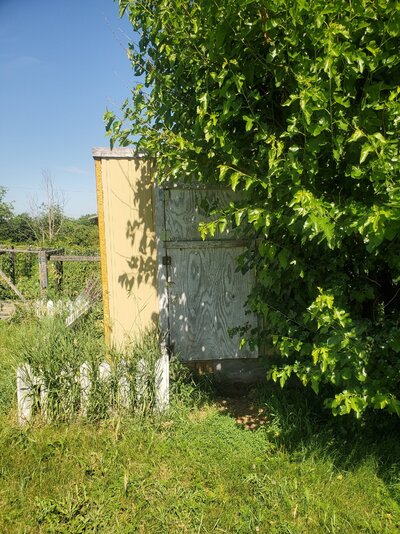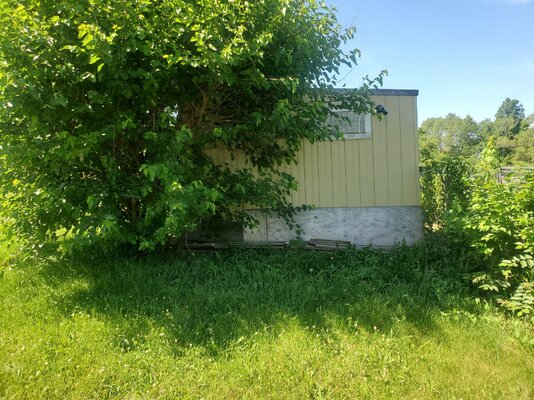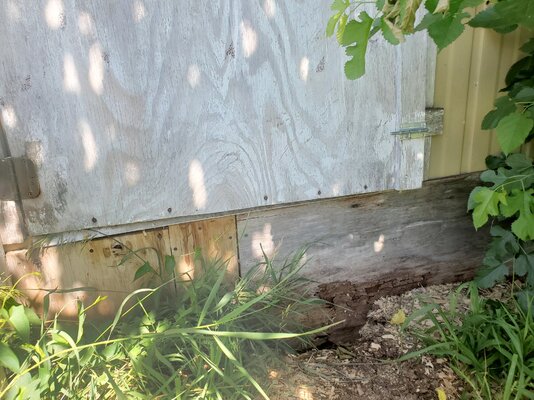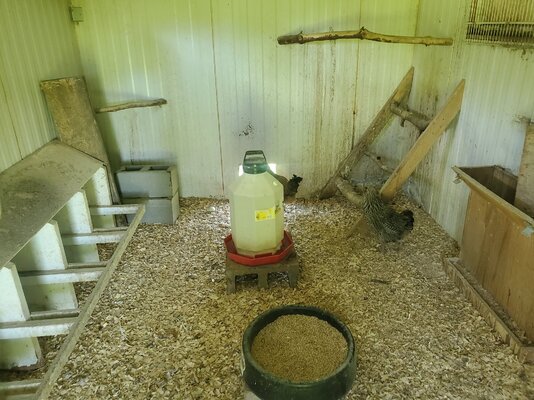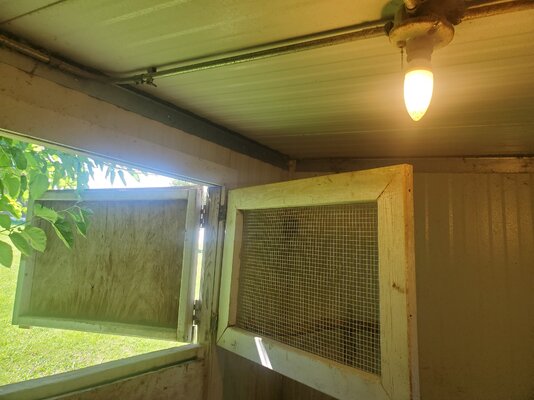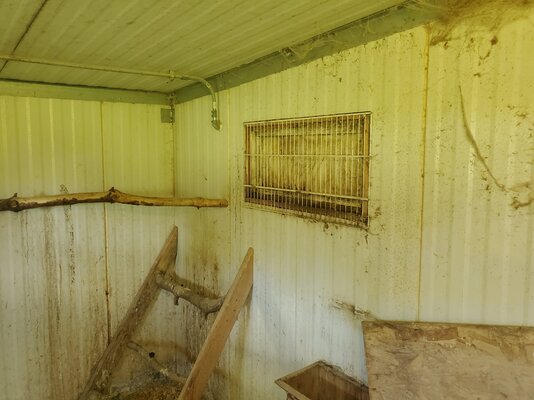Heyo! Old member coming back after several years -- I had a flock of 17 when I lived in Washington after getting out of the military, but still-enlisted Husbando got orders to California and the chickens couldn't come. Now that Lady Navy no longer gets a slice of me OR my man, we've contracted on a great house on 2 acres, which just so happens to have a large coop and chunnel around a garden (did I mention this was a great place??). HOWEVER, the coop is not 100% up to snuff, even though there are chickens already in it merrily pooping out eggs every day.
Pros:
It has electricity! Which is GREAT in case I ever want to do things that require that. It currently has a low wattage lightbulb but the days are long enough that the ventilation windows (2 of them, about 2 feet long by 8 inches-ish tall. this is me eyeballing and I'm bad at measurements) provide enough light inside.
It's metal. No rot! The roof seems to be in good condition, too.
The chicken tunnel is both in very good condition and tall enough that I can actually get into it and walk around while just stooping slightly. It is also about 3.5 feet wide around a 150 foot perimeter, so plenty o' room for fluffybutt activities. (see my previous statement on my eyeballing abilities, though)
Cons:
There's a big old tree cuddling up on it and getting in the way of everything. Can't open the second ventilation window.
The access door is warped and doesn't sit in the frame correctly. There is a gap of several inches on the bottom corner where it doesn't close all the way.
The coop is lifted off the ground about a foot, but the entire space is blocked in by plywood. The plywood is rotted in several spots, which cuts down pretty severely on coop security and while it IS shady there is very little airflow.
There is a mounted feeder inside that is not closed, and in fact doesn't have a lid at all, and is crammed full of feed. I startled several mice when I went into the coop to check things out. I don't like that.
It is dirty.
There are few roosting spots for large fowl adult birds. I was surprised at the lack of roost room, because the hens look to be austrolorps and larger birds. Even the easter eggers were pretty big compared to what I'm used to/remember. There is a roost ladder but it would probably only comfortably accommodate pullets or one grown hen on each rung.
These are my proposed alterations to address the issues I see. Mostly I'm looking for suggestions on improvements and whether what I want to do is a good idea or if it can be done in a smarter way. I will post photos in the next comment so look for those to see what I mean and give you a look at what I'm working with.
Fixes:
Trim the damn tree.
New access door. The current one is a dutch style with an upper screen, which I really like. Ideally I will be replacing the current door with a similar, better door.
Remove the plywood from the base of the coop and replace it with hardware cloth. This will maintain the dusty, cool area where the hens can go to hang out while allowing airflow and increasing security. I will make a hardware cloth apron and bury the excess/cover it with either pavers or brick.
Remove the mounted wood feeder and replace it with another type. I kind of like the wall mount but it might get in the way if I install a roosting bar along that side. I don't want poop to cover the feeder or risk getting into their feed. I am considering bucket feeders with spouts the chickens can stick their heads into to access food, lifted off the floor with cinder blocks.
I will remove all current bedding and deep clean the coop and nesting boxes. Do you prefer pine shavings or straw for bedding? I have access to both, but straw is more abundant where I live. I have done no research on the pros/cons of straw bedding for birds, though, and whether it is easier to compost than wood shavings. (no cedar, I know).
I will install roosting bars 2 to 3 feet off the floor of the coop, running along the long side of the structure on both sides. What do you recommend doing for poop trays under that? A plank? Does it get in the way of cleaning the coop? Do you recommend them at all? The nesting boxes are built along one of the walls and can't be moved.
While I didn't plan on keeping the current 6 chickens and asked the sellers to take them, there isn't much I can do if they just...leave them. I mean, I could rehome them, but I'd feel bad about it. They're sweet birds and they're laying like gangbusters. I have an order of 16 (2 cocks and 14 pullets) coming from Meyer at the end of August though and I planned on brooding in the coop. (One time inside was Enough and I don't ever want to do THAT again)
I am open to modifying my order for Fewer Chickens if yall think the space is not conducive, either with or without current hens. Any and all opinions are welcome, because I want to do this so my flock is happy and healthy.
Pros:
It has electricity! Which is GREAT in case I ever want to do things that require that. It currently has a low wattage lightbulb but the days are long enough that the ventilation windows (2 of them, about 2 feet long by 8 inches-ish tall. this is me eyeballing and I'm bad at measurements) provide enough light inside.
It's metal. No rot! The roof seems to be in good condition, too.
The chicken tunnel is both in very good condition and tall enough that I can actually get into it and walk around while just stooping slightly. It is also about 3.5 feet wide around a 150 foot perimeter, so plenty o' room for fluffybutt activities. (see my previous statement on my eyeballing abilities, though)
Cons:
There's a big old tree cuddling up on it and getting in the way of everything. Can't open the second ventilation window.
The access door is warped and doesn't sit in the frame correctly. There is a gap of several inches on the bottom corner where it doesn't close all the way.
The coop is lifted off the ground about a foot, but the entire space is blocked in by plywood. The plywood is rotted in several spots, which cuts down pretty severely on coop security and while it IS shady there is very little airflow.
There is a mounted feeder inside that is not closed, and in fact doesn't have a lid at all, and is crammed full of feed. I startled several mice when I went into the coop to check things out. I don't like that.
It is dirty.
There are few roosting spots for large fowl adult birds. I was surprised at the lack of roost room, because the hens look to be austrolorps and larger birds. Even the easter eggers were pretty big compared to what I'm used to/remember. There is a roost ladder but it would probably only comfortably accommodate pullets or one grown hen on each rung.
These are my proposed alterations to address the issues I see. Mostly I'm looking for suggestions on improvements and whether what I want to do is a good idea or if it can be done in a smarter way. I will post photos in the next comment so look for those to see what I mean and give you a look at what I'm working with.
Fixes:
Trim the damn tree.
New access door. The current one is a dutch style with an upper screen, which I really like. Ideally I will be replacing the current door with a similar, better door.
Remove the plywood from the base of the coop and replace it with hardware cloth. This will maintain the dusty, cool area where the hens can go to hang out while allowing airflow and increasing security. I will make a hardware cloth apron and bury the excess/cover it with either pavers or brick.
Remove the mounted wood feeder and replace it with another type. I kind of like the wall mount but it might get in the way if I install a roosting bar along that side. I don't want poop to cover the feeder or risk getting into their feed. I am considering bucket feeders with spouts the chickens can stick their heads into to access food, lifted off the floor with cinder blocks.
I will remove all current bedding and deep clean the coop and nesting boxes. Do you prefer pine shavings or straw for bedding? I have access to both, but straw is more abundant where I live. I have done no research on the pros/cons of straw bedding for birds, though, and whether it is easier to compost than wood shavings. (no cedar, I know).
I will install roosting bars 2 to 3 feet off the floor of the coop, running along the long side of the structure on both sides. What do you recommend doing for poop trays under that? A plank? Does it get in the way of cleaning the coop? Do you recommend them at all? The nesting boxes are built along one of the walls and can't be moved.
While I didn't plan on keeping the current 6 chickens and asked the sellers to take them, there isn't much I can do if they just...leave them. I mean, I could rehome them, but I'd feel bad about it. They're sweet birds and they're laying like gangbusters. I have an order of 16 (2 cocks and 14 pullets) coming from Meyer at the end of August though and I planned on brooding in the coop. (One time inside was Enough and I don't ever want to do THAT again)
I am open to modifying my order for Fewer Chickens if yall think the space is not conducive, either with or without current hens. Any and all opinions are welcome, because I want to do this so my flock is happy and healthy.
Last edited:

